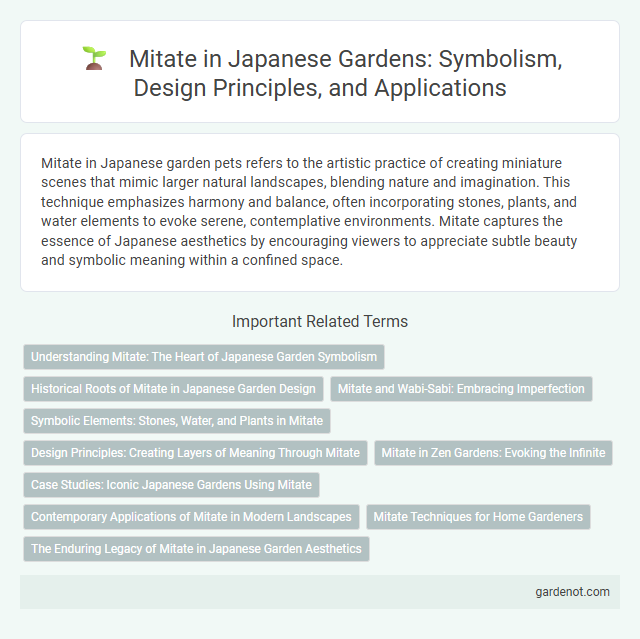Mitate in Japanese garden pets refers to the artistic practice of creating miniature scenes that mimic larger natural landscapes, blending nature and imagination. This technique emphasizes harmony and balance, often incorporating stones, plants, and water elements to evoke serene, contemplative environments. Mitate captures the essence of Japanese aesthetics by encouraging viewers to appreciate subtle beauty and symbolic meaning within a confined space.
Understanding Mitate: The Heart of Japanese Garden Symbolism
Mitate, a core concept in Japanese garden design, embodies the art of symbolic substitution, where ordinary elements represent broader natural or philosophical ideas. This technique transforms physical features into metaphors, such as stones symbolizing mountains or water representing rivers, deepening visitors' emotional and spiritual engagement. Understanding mitate reveals the garden's layered meanings, enriching appreciation of its cultural and aesthetic significance.
Historical Roots of Mitate in Japanese Garden Design
Mitate in Japanese garden design originates from Edo period aesthetics, emphasizing playful reinterpretation of natural landscapes through symbolic miniatures. This technique reflects Zen Buddhist principles by encouraging viewers to experience multiple layers of meaning in a confined space. Historically, mitate demonstrates the fusion of artistic creativity and philosophical depth, deeply influencing traditional garden composition and cultural expression.
Mitate and Wabi-Sabi: Embracing Imperfection
Mitate in Japanese gardens highlights the art of creative substitution, where ordinary objects represent something else, embodying the Wabi-Sabi philosophy of embracing imperfection and impermanence. This technique transforms asymmetry, irregularity, and simplicity into profound aesthetic expressions, celebrating natural beauty in its incomplete and transient forms. Mitate encourages viewers to find deeper meaning and mindfulness by appreciating subtle details and the poetic ambiguity inherent in Wabi-Sabi ideals.
Symbolic Elements: Stones, Water, and Plants in Mitate
Stones, water, and plants in Mitate serve as symbolic elements that evoke deeper meanings within Japanese gardens, representing natural landscapes and philosophical concepts through their intentional arrangement. Carefully selected stones often symbolize mountains or islands, while water features, such as ponds or streams, reflect purity and the flow of life. Plants are chosen not only for their seasonal beauty but also for their cultural significance, embodying the transient nature of existence and harmony with the environment.
Design Principles: Creating Layers of Meaning Through Mitate
Mitate in Japanese garden design employs layered symbolism by juxtaposing elements that evoke multiple interpretations, enriching the visitor's experience. This principle integrates natural and cultural references, such as stones resembling mountains or plants symbolizing seasons, to create depth and contemplation. Through subtle visual metaphors, Mitate invites reflection on nature's cycles and poetic imagery within the garden's spatial arrangement.
Mitate in Zen Gardens: Evoking the Infinite
Mitate in Zen gardens creates a profound sense of infinity by symbolically representing vast landscapes within a confined space, often using carefully placed stones, plants, and water features. This technique encourages deep reflection by inviting viewers to perceive endless horizons and boundless natural scenes in the garden's microcosm. Mitate's use of suggestive elements fosters a contemplative experience, aligning with Zen principles of mindfulness and impermanence.
Case Studies: Iconic Japanese Gardens Using Mitate
Iconic Japanese gardens such as Ryoan-ji in Kyoto and Adachi Museum of Art Garden exemplify the use of mitate, a technique that reinterprets natural landscapes through symbolic elements. Ryoan-ji's rock garden uses carefully placed stones as mitate for mountains and islands, inviting meditation on scale and perspective. The Adachi Garden employs mitate by blending meticulously pruned trees and water features to evoke famous scenic views, demonstrating the artful fusion of nature and symbolism.
Contemporary Applications of Mitate in Modern Landscapes
Mitate in Japanese gardens transforms traditional motifs by reinterpreting classical elements such as stone arrangements and plant selections to reflect contemporary aesthetics. Modern landscape designers employ Mitate to create spaces that evoke cultural memory while integrating urban minimalism and sustainability practices. This blending of old and new fosters unique, contemplative environments that resonate with both historical significance and modern lifestyle.
Mitate Techniques for Home Gardeners
Mitate techniques in Japanese gardens involve creative substitutions and symbolic representations to evoke natural landscapes in compact spaces, ideal for home gardeners. By using miniature plants, stones, and water features, mitate recreates mountains, rivers, and seasonal changes, enhancing aesthetic depth and cultural meaning. Mastery of mitate allows home garden enthusiasts to design serene, meaningful spaces that capture the essence of traditional Japanese garden beauty.
The Enduring Legacy of Mitate in Japanese Garden Aesthetics
Mitate, the art of poetic substitution and visual metaphor, remains a cornerstone of Japanese garden aesthetics, enhancing meaning through symbolic elements like stones, plants, and water features. This technique invites viewers to engage in imaginative interpretation, fostering a deep, layered appreciation that transcends literal appearances. Its enduring legacy shapes the tranquil ambiance and philosophical depth characteristic of traditional Japanese gardens.
Mitate Infographic

 gardenot.com
gardenot.com